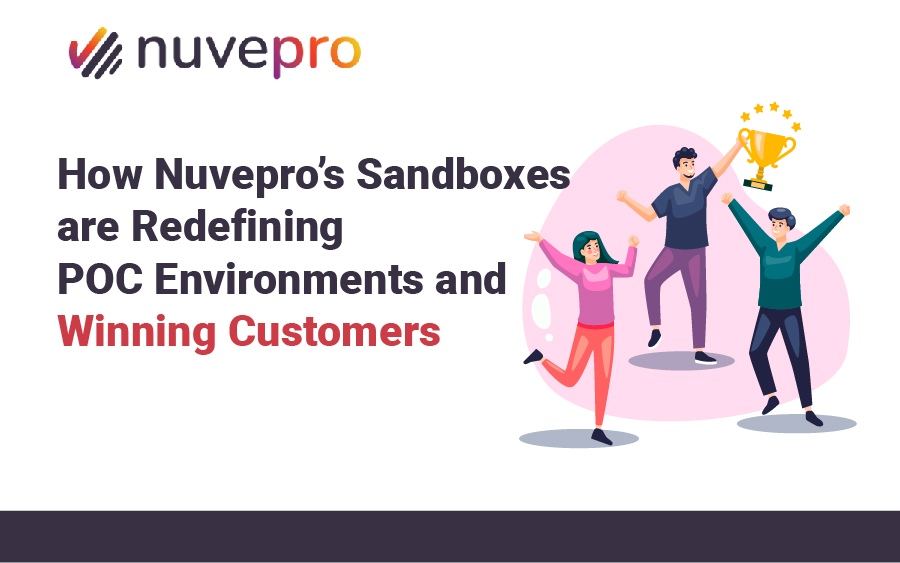In today’s competitive business landscape, demonstrating your capabilities effectively can be the difference between winning and losing a customer. One of the most powerful tools in your arsenal for this is a well-executed Proof of Concept (POC). At Nuvepro, we understand the challenges and opportunities that come with creating impactful POCs, which is why we offer sandbox environments designed to help you demonstrate your solutions seamlessly.
What are Sandboxes?
Imagine a playground for your ideas, where you can test, tweak, and demonstrate your solutions without any real-world consequences. That’s what a sandbox environment is. It’s a controlled, secure space where you can build and experiment with your applications, technologies, and workflows. Nuvepro’s sandboxes provide this space, allowing you to create robust POC environments that can impress potential clients and stakeholders.
Why Use Sandboxes for POCs?
1. Risk-Free Experimentation
One of the biggest advantages of using sandboxes is the ability to experiment without fear of causing disruptions. In a sandbox, you can test various configurations, integrations, and functionalities to ensure that your solution works perfectly before presenting it to a client. This risk-free environment fosters innovation and creativity, enabling you to explore new ideas and approaches.
2. Speed and Agility
Time is often of the essence when creating a POC. Traditional environments can be slow to set up and cumbersome to manage. Nuvepro’s sandboxes are designed for speed and agility. You can quickly spin up new environments, make changes on the fly, and iterate rapidly. This agility allows you to respond to client feedback and requirements in real-time, ensuring that your POC remains relevant and compelling.
3. Cost Efficiency
Building and maintaining traditional POC environments can be expensive. Hardware, software licenses, and infrastructure costs add up quickly. Sandboxes, on the other hand, offer a cost-effective alternative. With Nuvepro’s pay-as-you-go model, you only pay for the resources you use, making it easier to manage budgets and reduce overall expenses.
How to Create an Effective POC Environment with Nuvepro’s Sandboxes
Step 1: Define Your Objectives
Before diving into the technical setup, it’s crucial to clearly define what you want to achieve with your POC. What problem are you solving? What value will your solution bring to the client? Having a well-defined objective will guide your efforts and ensure that your POC is focused and impactful.
Step 2: Choose the Right Tools and Technologies
Nuvepro’s sandboxes support a wide range of tools and technologies, from cloud platforms like AWS, GCP and Azure to development frameworks and software applications. Select the tools that best suit your project requirements and client needs. This flexibility allows you to tailor your POC environment to specific scenarios, demonstrating your expertise and versatility.
Step 3: Build and Test Your Solution
With your objectives defined and tools selected, it’s time to start building. Use the sandbox environment to develop your solution, integrating various components and testing their functionality. This iterative process helps identify and resolve issues early, ensuring that your final POC is polished and reliable.
Step 4: Showcase Your POC
Once your solution is ready, it’s time to showcase it to your client. Use the sandbox environment to demonstrate key features, workflows, and benefits. Highlight how your solution addresses the client’s pain points and delivers value. A well-executed demonstration can leave a lasting impression, increasing your chances of winning the customer.
Enhancing Collaboration and Communication
Creating a POC isn’t just about technical execution; it’s also about effective communication and collaboration. Nuvepro’s sandboxes enable seamless collaboration among team members, regardless of their geographical location. You can invite stakeholders, including clients, to view and interact with the POC environment in real-time. This collaborative approach not only enhances transparency but also allows for immediate feedback, ensuring that the final solution aligns perfectly with the client’s expectations.
Ensuring Security and Compliance
In today’s digital age, security and compliance are paramount. Nuvepro’s sandboxes are designed with robust security features to protect your data and intellectual property. Each sandbox environment is isolated, ensuring that your experiments and demonstrations are secure from external threats. Additionally, our sandboxes comply with industry standards and regulations, giving you peace of mind when handling sensitive information.
Continuous Learning and Improvement
One of the key benefits of using Nuvepro’s sandboxes is the opportunity for continuous learning and improvement. Every POC you create is a learning experience, providing insights into what works and what doesn’t. This iterative process allows you to refine your approach, enhance your technical skills, and stay ahead of the competition. By leveraging the feedback and data from each POC, you can continuously improve your solutions and deliver even greater value to your clients.
The Future of POC Environments
As technology continues to evolve, so too will the capabilities of sandbox environments. Nuvepro is committed to staying at the forefront of these advancements, continually enhancing our sandboxes to meet the changing needs of our clients. From integrating emerging technologies like AI and machine learning to providing advanced analytics and reporting tools, we are dedicated to providing you with the most powerful and flexible POC environments available.
Conclusion: Elevate Your POCs with Nuvepro’s Sandboxes
In the world of business, first impressions matter. A well-crafted POC can make all the difference in securing a new customer or investment. Nuvepro’s sandboxes offer a powerful, flexible, and cost-effective way to create these impactful demonstrations. By leveraging our sandbox environments, you can experiment freely, respond quickly, and showcase your solutions with confidence.
So, the next time you’re gearing up to win that big client, remember the power of a sandbox. It’s more than just a testing environment; it’s a platform for innovation and success. Embrace the possibilities and let Nuvepro’s sandboxes help you turn your POCs into winning propositions.




